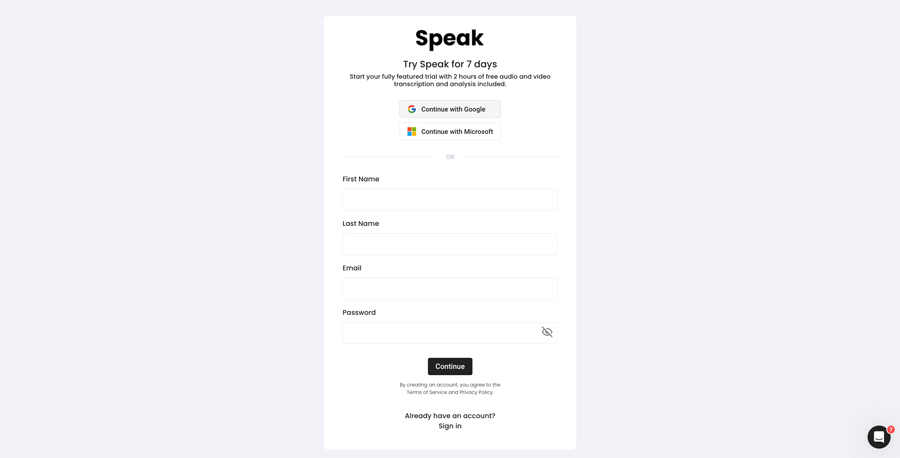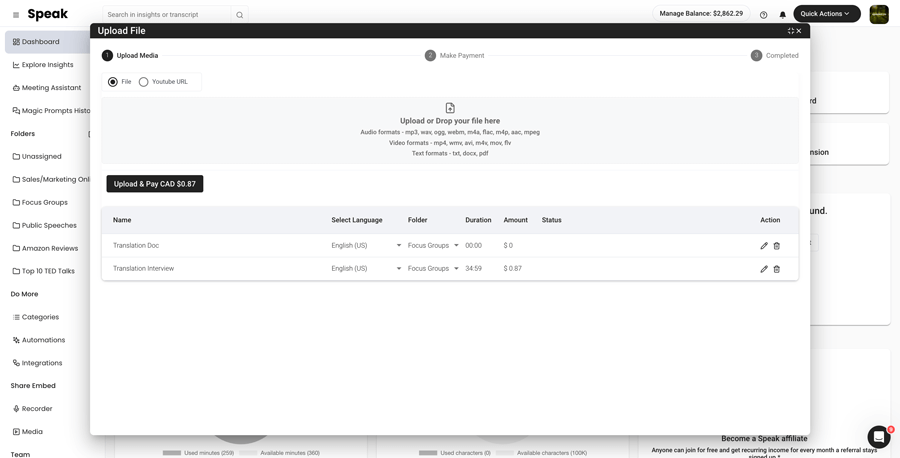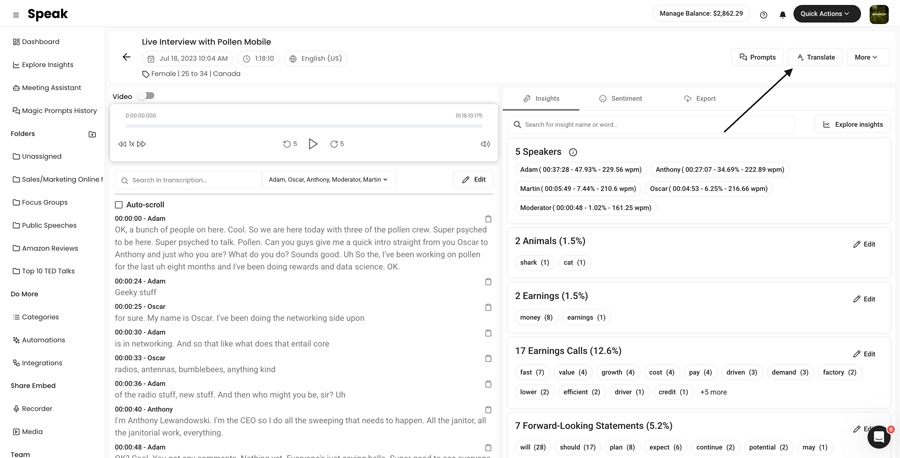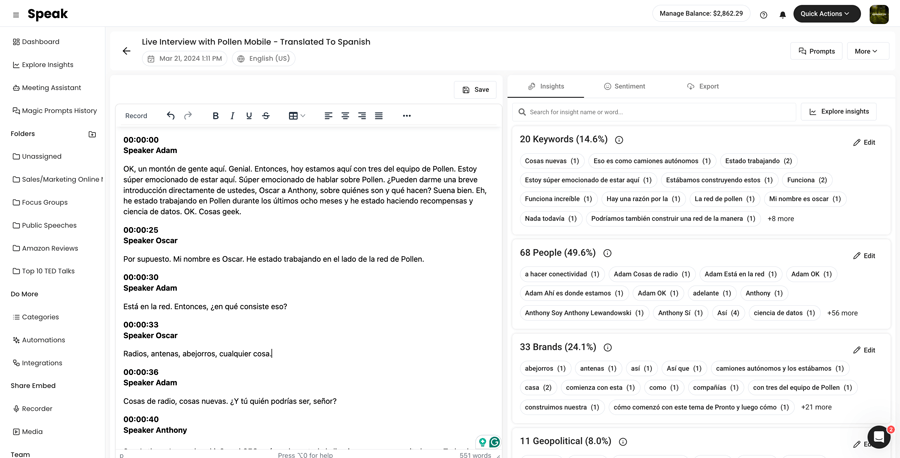How To Translate English (Irish) to Chinese (Simplified)
Translating English (Irish) to Chinese (Simplified) is super simple!

Step 1: Register for Speak
Register for Speak using this link.
Once you register, you can instantly begin translating your English (Irish) to Chinese (Simplified) file(s).

Step 2: Upload Your English (Irish) file(s)
As soon as you log in, you will be redirected to the dashboard.
Once there, you can select the Quick Action "New Upload".
In Speak, you can seamlessly upload, transcribe and translate audio, video and text files all at once!

Step 3: Translate Your English (Irish) file(s) to Chinese (Simplified)
Once the file is uploaded, simply visit your file and select "Translate".
If it is an audio and video file, Speak will ask you if you want to keep the speaker names and timestamps in the translation.
Want to translate many files at once? No problem!
You can view the files you want to automatically translate from English (Irish) to Chinese (Simplified) from the folder level and instantly translate as many files as you need with our artificial intelligence translation in just a few clicks.

Step 4: That's It! View, Analyze, Modify & Export Your New Chinese (Simplified) file(s)
Once the translation is done, you will be alerted and you will see a new document in the same folder your original file is in.
The file will be named the same but with a dash indicating that it is the translated version.
Need support with your English (Irish) translation?
We are always here and happy to help at Speak!
Just send us a message on live chat on the bottom right corner and we will ensure you are set up for success.
Interested in translating English (Irish) or other languages to different languages? View our entire list of supported translation languages here.
Automatic, accurate, instant AI translation from English (Irish) to Chinese (Simplified) is here for you.
Register for Speak using this link and begin translating English (Irish) to Chinese (Simplified) today.
Unlocking Global Communication: Translate English (Irish) to Chinese (Simplified)
In an ever-connected global village, the power of language bridges cultures, fuels trade, and forges strong international relationships. With the rapid evolution of technology, the barriers to global communication are quickly disappearing. Speak AI is at the forefront of this revolution, offering cutting-edge solutions for translating English (Irish) to Chinese (Simplified). Let's delve into the world of AI translation and explore how automatic translation can benefit researchers and businesses alike.
The Vital Role of AI Translation
In an era where information moves at the speed of light, quick and accurate translation has become indispensable. The process of translating languages like English (Irish) and Chinese (Simplified) involves not just converting words but also conveying cultural nuances and contexts. Here, AI translation and the support from Speak AI's advanced NLP, large language models, and data visualization technologies come into their own, offering seamless, efficient, and contextually accurate translations.
Enhancing Global Business Operations
For businesses looking to expand their reach into new markets, the ability to communicate effectively in the local language is a game-changer. Speak AI helps businesses break down language barriers, ensuring that their products, services, and marketing messages are culturally relevant and easily understood by target audiences. This not only strengthens brand presence but also greatly enhances customer engagement across borders.
The Efficiency of Automatic Translation
Time is money, especially in the fast-paced world of international trade. Automatic translation significantly reduces the turnaround time compared to traditional translation methods, providing instant translations of audio, video, and text content. This efficiency opens up new opportunities for real-time communication and collaboration, driving innovation and growth.
Cost-Effective Solutions
The integration of AI-driven technologies by Speak AI not only ensures high-quality translations but also offers a cost-effective solution for businesses. By automating the translation process, companies can save on the expenses associated with professional translators while still ensuring their messages are accurately conveyed in Chinese (Simplified).
Breaking Through Academic and Research Barriers
For researchers, access to studies, papers, and sources in multiple languages can be a hurdle. Speak AI's translation capabilities empower researchers to explore a wider range of literature, gain diverse insights, and contribute more effectively to global knowledge. By translating research findings from English (Irish) to Chinese (Simplified) and vice versa, Speak AI facilitates a richer, more inclusive academic dialogue.
Where English (Irish) and Chinese (Simplified) Dominate
English (Irish) is predominantly spoken in Ireland, with nearly 40% of the population claiming some ability to speak the language. It adds a rich cultural layer to the global English linguistic tapestry. On the other hand, Chinese (Simplified) is used by over a billion people, mainly in the People's Republic of China and Singapore, making it one of the most important languages in global economic and cultural exchanges.
Interesting Stats and Fun Facts
Despite their differences, English (Irish) and Chinese (Simplified) share a fascinating interplay in history and culture. For example, did you know that the word "tea" in English is derived from the Chinese word "茶 (chá)", reflecting the long history of tea trade between the English-speaking world and China?
Differences and Similarities
While English (Irish) and Chinese (Simplified) may seem worlds apart, both languages share universal aspects of human communication - the expression of ideas, emotions, and cultures. One major difference lies in their writing systems: English (Irish) uses the Latin alphabet, while Chinese (Simplified) uses characters, each representing a word or a syllable. However, both languages have adapted and evolved, incorporating foreign words and concepts, demonstrating the dynamic nature of linguistic exchange.
Closing Thoughts
As the world grows smaller, the ability to communicate across linguistic divides becomes more crucial. Speak AI stands ready to assist businesses and researchers in bridging these divides, providing powerful tools for translation from English (Irish) to Chinese (Simplified). With Speak AI, you unlock a world of possibilities, fostering connections and understanding across the globe.
Embrace the future of communication with Speak AI's automatic translation services. Dive deep into new markets, engage with diverse audiences, and contribute to a truly interconnected world. Sign up today to experience the difference!
---
Answering Your Questions
What locations are English (Irish) and Chinese (Simplified) popular?
English (Irish), a variant of English spoken in Ireland, blends traditional English with unique Irish phrases and vocabulary. It's prevalent in Ireland, where it coexists with Irish Gaelic. Chinese (Simplified), on the other hand, is primarily used in Mainland China, Singapore, and by Chinese diasporas worldwide. It's important for not only daily communication but also in business, technology, and cultural exchanges globally.
Interesting stats on countries, populations, and history
Ireland has a rich linguistic history, with English (Irish) deeply ingrained in its culture. Approximately 1.3 million people in Ireland can speak or understand Irish English. In contrast, Chinese (Simplified) boasts over a billion speakers, making it one of the most spoken languages worldwide, indicating the significant cultural and economic influence of China.
Some fun facts about English (Irish) and Chinese (Simplified)
One fun fact is that the oldest known book printed with movable metal type is in Chinese, dating back to 1377, highlighting China's long history of innovation. In Ireland, the earliest form of writing, Ogham script, was used between the 4th and 7th centuries and can still be seen on some ancient stones today.
Differences and similarities between English (Irish) AND Chinese (Simplified)
While the two languages differ significantly in syntax, grammar, and writing systems, they share a capacity for rich expression and cultural nuance. Both have absorbed and adapted loanwords from other languages, reflecting their dynamic and evolving nature in the face of globalization.
Translate English (Irish) To These Other Supported Languages:
- Translate English (Irish)-to-Albanian
- Translate English (Irish)-to-Amharic
- Translate English (Irish)-to-Arabic (Egypt)
- Translate English (Irish)-to-Arabic (Iraq)
- Translate English (Irish)-to-Arabic (Israel)
- Translate English (Irish)-to-Arabic (Jordan)
- Translate English (Irish)-to-Arabic (Kuwait)
- Translate English (Irish)-to-Arabic (Lebanon)
- Translate English (Irish)-to-Arabic (Oman)
- Translate English (Irish)-to-Arabic (Palestinian Authority)
- Translate English (Irish)-to-Arabic (Qatar)
- Translate English (Irish)-to-Arabic (Saudi Arabia)
- Translate English (Irish)-to-Arabic (Syrian Arab Republic)
- Translate English (Irish)-to-Arabic (United Arab Emirates)
- Translate English (Irish)-to-Arabic Modern Standard (Bahrain)
- Translate English (Irish)-to-Armenian
- Translate English (Irish)-to-Azerbaijani
- Translate English (Irish)-to-Bengali
- Translate English (Irish)-to-Bosnian
- Translate English (Irish)-to-Bulgarian
- Translate English (Irish)-to-Catalan
- Translate English (Irish)-to-Chinese (Cantonese, Traditional)
- Translate English (Irish)-to-Chinese (Simplified)
- Translate English (Irish)-to-Chinese (Traditional)
- Translate English (Irish)-to-Croatian
- Translate English (Irish)-to-Czech
- Translate English (Irish)-to-Danish
- Translate English (Irish)-to-Dari
- Translate English (Irish)-to-Dutch
- Translate English (Irish)-to-English
- Translate English (Irish)-to-English (Australia)
- Translate English (Irish)-to-English (India)
- Translate English (Irish)-to-English (Ireland)
- Translate English (Irish)-to-English (New Zealand)
- Translate English (Irish)-to-English (Scottish)
- Translate English (Irish)-to-English (South African)
- Translate English (Irish)-to-English (United Kingdom)
- Translate English (Irish)-to-English (United States)
- Translate English (Irish)-to-Estonian
- Translate English (Irish)-to-Farsi (Persian)
- Translate English (Irish)-to-Finnish
- Translate English (Irish)-to-French
- Translate English (Irish)-to-French (Canada)
- Translate English (Irish)-to-Georgian
- Translate English (Irish)-to-German
- Translate English (Irish)-to-German (Swiss)
- Translate English (Irish)-to-Greek
- Translate English (Irish)-to-Gujarati
- Translate English (Irish)-to-Haitian Creole
- Translate English (Irish)-to-Hausa
- Translate English (Irish)-to-Hebrew
- Translate English (Irish)-to-Hindi
- Translate English (Irish)-to-Hungarian
- Translate English (Irish)-to-Icelandic
- Translate English (Irish)-to-Indonesian
- Translate English (Irish)-to-Irish
- Translate English (Irish)-to-Italian
- Translate English (Irish)-to-Japanese
- Translate English (Irish)-to-Kannada
- Translate English (Irish)-to-Kazakh
- Translate English (Irish)-to-Korean
- Translate English (Irish)-to-Latvian
- Translate English (Irish)-to-Lithuanian
- Translate English (Irish)-to-Macedonian
- Translate English (Irish)-to-Malay
- Translate English (Irish)-to-Malayalam
- Translate English (Irish)-to-Maltese
- Translate English (Irish)-to-Marathi
- Translate English (Irish)-to-Mongolian
- Translate English (Irish)-to-Norwegian
- Translate English (Irish)-to-Pashto
- Translate English (Irish)-to-Persian
- Translate English (Irish)-to-Polish
- Translate English (Irish)-to-Portuguese
- Translate English (Irish)-to-Portuguese (Brazilian)
- Translate English (Irish)-to-Portuguese (Portugal)
- Translate English (Irish)-to-Punjabi
- Translate English (Irish)-to-Romanian
- Translate English (Irish)-to-Russian
- Translate English (Irish)-to-Serbian
- Translate English (Irish)-to-Sinhala
- Translate English (Irish)-to-Slovak
- Translate English (Irish)-to-Slovenian
- Translate English (Irish)-to-Somali
- Translate English (Irish)-to-Spanish
- Translate English (Irish)-to-Spanish (Mexico)
- Translate English (Irish)-to-Swahili
- Translate English (Irish)-to-Swedish
- Translate English (Irish)-to-Tamil
- Translate English (Irish)-to-Telugu
- Translate English (Irish)-to-Thai
- Translate English (Irish)-to-Turkish
- Translate English (Irish)-to-Ukrainian
- Translate English (Irish)-to-Urdu
- Translate English (Irish)-to-Uzbek
- Translate English (Irish)-to-Vietnamese
- Translate English (Irish)-to-Welsh



